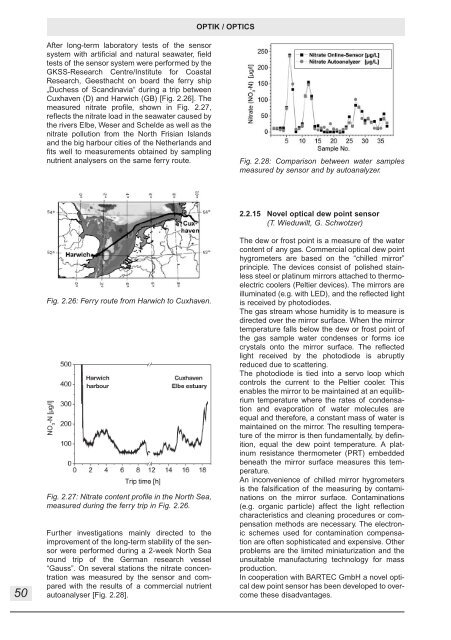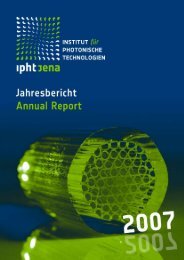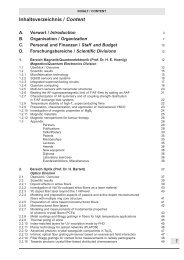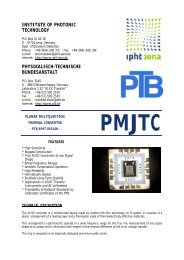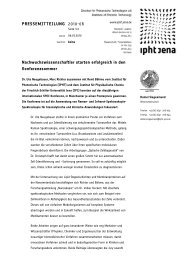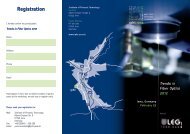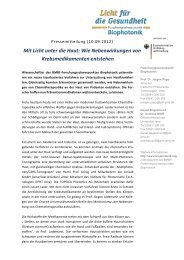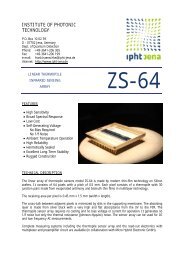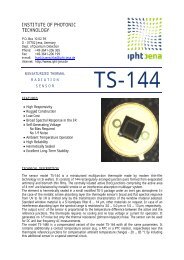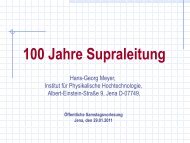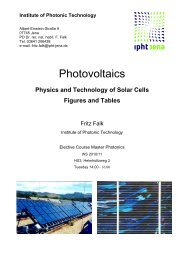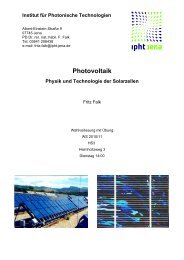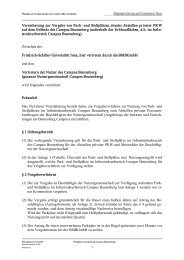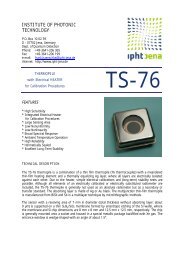Jahresbericht 2005 - IPHT Jena
Jahresbericht 2005 - IPHT Jena
Jahresbericht 2005 - IPHT Jena
Create successful ePaper yourself
Turn your PDF publications into a flip-book with our unique Google optimized e-Paper software.
50<br />
After long-term laboratory tests of the sensor<br />
system with artificial and natural seawater, field<br />
tests of the sensor system were performed by the<br />
GKSS-Research Centre/Institute for Coastal<br />
Research, Geesthacht on board the ferry ship<br />
„Duchess of Scandinavia“ during a trip between<br />
Cuxhaven (D) and Harwich (GB) [Fig. 2.26]. The<br />
measured nitrate profile, shown in Fig. 2.27,<br />
reflects the nitrate load in the seawater caused by<br />
the rivers Elbe, Weser and Schelde as well as the<br />
nitrate pollution from the North Frisian Islands<br />
and the big harbour cities of the Netherlands and<br />
fits well to measurements obtained by sampling<br />
nutrient analysers on the same ferry route.<br />
Fig. 2.26: Ferry route from Harwich to Cuxhaven.<br />
Fig. 2.27: Nitrate content profile in the North Sea,<br />
measured during the ferry trip in Fig. 2.26.<br />
Further investigations mainly directed to the<br />
improvement of the long-term stability of the sensor<br />
were performed during a 2-week North Sea<br />
round trip of the German research vessel<br />
“Gauss”. On several stations the nitrate concentration<br />
was measured by the sensor and compared<br />
with the results of a commercial nutrient<br />
autoanalyser [Fig. 2.28].<br />
OPTIK / OPTICS<br />
Fig. 2.28: Comparison between water samples<br />
measured by sensor and by autoanalyzer.<br />
2.2.15 Novel optical dew point sensor<br />
(T. Wieduwilt, G. Schwotzer)<br />
The dew or frost point is a measure of the water<br />
content of any gas. Commercial optical dew point<br />
hygrometers are based on the “chilled mirror”<br />
principle. The devices consist of polished stainless<br />
steel or platinum mirrors attached to thermoelectric<br />
coolers (Peltier devices). The mirrors are<br />
illuminated (e.g. with LED), and the reflected light<br />
is received by photodiodes.<br />
The gas stream whose humidity is to measure is<br />
directed over the mirror surface. When the mirror<br />
temperature falls below the dew or frost point of<br />
the gas sample water condenses or forms ice<br />
crystals onto the mirror surface. The reflected<br />
light received by the photodiode is abruptly<br />
reduced due to scattering.<br />
The photodiode is tied into a servo loop which<br />
controls the current to the Peltier cooler. This<br />
enables the mirror to be maintained at an equilibrium<br />
temperature where the rates of condensation<br />
and evaporation of water molecules are<br />
equal and therefore, a constant mass of water is<br />
maintained on the mirror. The resulting temperature<br />
of the mirror is then fundamentally, by definition,<br />
equal the dew point temperature. A platinum<br />
resistance thermometer (PRT) embedded<br />
beneath the mirror surface measures this temperature.<br />
An inconvenience of chilled mirror hygrometers<br />
is the falsification of the measuring by contaminations<br />
on the mirror surface. Contaminations<br />
(e.g. organic particle) affect the light reflection<br />
characteristics and cleaning procedures or compensation<br />
methods are necessary. The electronic<br />
schemes used for contamination compensation<br />
are often sophisticated and expensive. Other<br />
problems are the limited miniaturization and the<br />
unsuitable manufacturing technology for mass<br />
production.<br />
In cooperation with BARTEC GmbH a novel optical<br />
dew point sensor has been developed to overcome<br />
these disadvantages.


